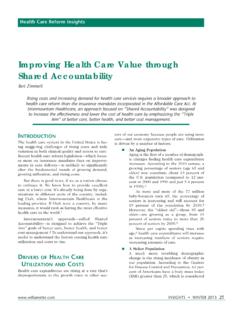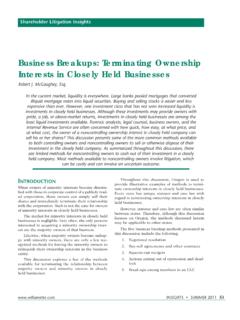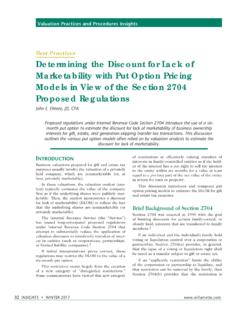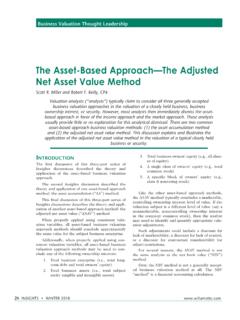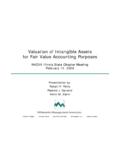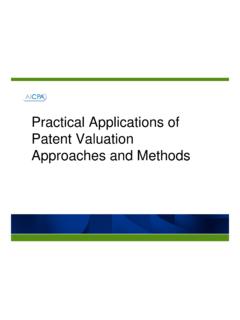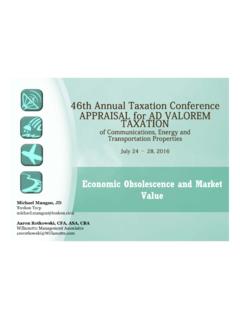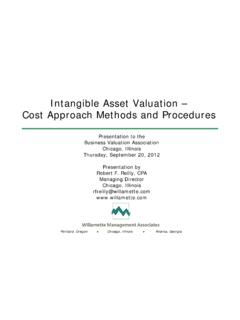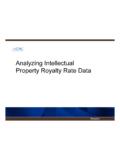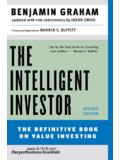Transcription of Voting Stock and Nonvoting Stock: Allocating …
1 Www .willamette .com insights SUMMER 2012 33 Voting Stock and Nonvoting Stock : Allocating equity ValueAaron M. RotkowskiGift and Estate Tax Valuation InsightsBusiness valuations performed for gift tax or estate tax purposes often involve the valuation of companies that are capitalized with both Voting Stock and Nonvoting Stock . In these situations, the analyst should perform two additional procedures that would not be required if the company was capitalized with only one class of Stock : the analyst must (1) estimate a premium for Voting rights (or a discount for lack of Voting rights) and (2) allocate value between the company s Voting Stock and Nonvoting Stock .
2 This discussion addresses the second additional procedure. Specifically, this discussion presents two methods that the valuation analyst can use to allocate value between a company s Voting Stock and Nonvoting Stock . This discussion also explores the strengths and weaknesses of those two equity allocation analysts are often asked to value owner-ship interests in closely held companies for gift tax or estate tax planning purposes. Sometimes, the company that is the valuation subject is capitalized with two kinds of equity :1. equity that has the right to vote2. equity that has a relatively limited right (or no right) to voteIn these situations, the valuation analyst may have to allocate value between a Voting ownership interest and a Nonvoting ownership multiple owners each own a different number of the company s shares or a different class of shares, it is possible that the sum of all of the multiple owners shares times each share s value will not equal the total equity value (except perhaps in a takeover transaction).
3 The sum of all of the multiple owners shares times each share s value may not equal the total equity value as a result of the application of valu-ation discounts (1) for lack of control and (2) for lack of marketability. Another reason for this result is the application of a valuation discount for the lack of Voting to the valuation discounts for lack of control and/or for lack of marketability, the size of the valuation discount for the lack of Voting rights is typically not as application of a discount to reflect the differ-ence in value between a share of Stock that has the right to vote and a share of Stock that does not have such a right is encountered with some regularity by valuation issue is particularly relevant when a block of shares.
4 The value of which is already known, is disaggregated between two classes of an illustrative example of equity allocation, let s assume the following:1. An investor acquired 100 Voting shares and 900 Nonvoting shares in Company One for $5, Each Voting share costs 5 percent more than each Nonvoting insights SUMMER 2012 www .willamette .comGiven these fact, how much did the investor pay for each Nonvoting share?In another situation, after recognizing valuation adjustments for lack of control and lack of market-ability, the fair market value at a noncontrolling, nonmarketable level of value of all of the total 20,000 Voting and Nonvoting shares of equity of Company Two is $100, , let s assume the following:1.
5 An investor holds 100 Voting shares and 900 Nonvoting shares of Company Two Each Voting share is worth 5 percent more per share than each Nonvoting these facts, how much is each of the inves-tor s Nonvoting shares worth?To answer the questions posed in the illustrative fact set, the valuation analyst should first select a method to allocate equity value between multiple classes of Stock . The analyst should next allocate the subject company equity value using the selected allocation discussion presents two methods that the valuation analyst can use to allocate the total equity value between the Voting Stock and the Nonvoting Stock in a corporation.
6 This discussion also presents an explanation of the strengths and weaknesses of these two equity allocation two equity allocation methods that are discussed herein are the most common allocation methods used by valuation analysts. In addition, there are other, infrequently used, equity allocation methods available to , since other total equity allocation methods are typically not applied in practice, they are not included in this For lack oF Voting riGhts ( Voting riGhts PrEMiu M)Closely held companies are often capitalized with multiple classes of Stock .
7 One common ownership structure is a closely held corporation that is capi-talized with a small number of Voting shares and a large number of Nonvoting ownership structure is commonly recom-mended by estate planners because it enables the senior owners ( , the parents) to transfer large economic interests in a closely held company to the next generation ( , the children) without giving up control of the business company Voting Stock and Nonvoting Stock are often identical except for the difference in vot-ing rights granted to each class of Nonvoting Stock is the subject of a valu-ation assignment, the relative difference in value between the Voting Stock and Nonvoting Stock is quantified.
8 This is usually accomplished by one of the following two procedures:1. Estimating the value of the company s non- Voting Stock and applying a premium for Voting rights (PVR)2. Estimating the value of the company s vot-ing Stock and applying a discount for lack of Voting rights (DLVR)This discussion assumes that the valuation ana-lyst has already selected an appropriate DLVR/PVR. One way to estimate the DLVR/PVR is to analyze the trading price of the shares of publicly traded purpose of this discussion is to describe two methods of Allocating total equity value between Voting shares and Nonvoting shares of a closely held company after the analysis of the size of the DLVR/PVR has been , to put the equity allocation method in context, the next section of this discussion presents a high level overview of the following:1.
9 The various DLVR/PVR empirical studies2. The rationale for selecting a particular DLVR/PVRoVErViEw oF thE issuEIntuitively, a share of Stock that has more favorable economic attributes has a higher fair market value than a share of Stock with less favorable economic .willamette .com insights SUMMER 2012 35As explained below, having the right to vote is better than not having that right:Empirical evidence indicates that the Stock market price for publicly traded Voting common shares is generally greater than the Stock market price for comparable publicly traded Nonvoting shares.
10 Empirical evidence also indicates that the Stock mar-ket price for supervoting common Stock is generally greater than the Stock market price for otherwise comparable normal vot-ing common Stock . These empirical data indicate that the shareholders pay a price premium for Voting privileges related to the common shares of a public corporation. And, these empirical data also indicate that shareholders will extract a price discount for the lack of Voting privileges related to the common shares of a public Management Associates and others have studied this price difference and published the results of their studies.

